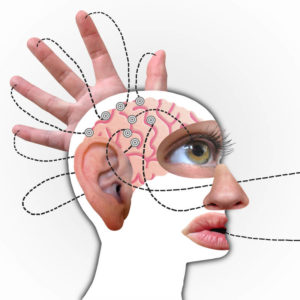When I was in school there was this kid, Dave. He remembered all of his dreams, so he said.
They’d be crazy. They’d have monsters in them, people with no faces, and talking ducks.
Every so often he’d keep us entertained before school and at recess with his tales from the night before.
Sometimes his dreams would be scary.

Other times they’d be funny.
They’d always be interesting.
Part of it was Dave was a good storyteller.
Part of was having the dreams themselves.
I rarely remembered my dreams
I was jealous.
When I went to bed, I slept. That’s it. I’d wake up in the morning and all that would have happened is that time had passed.
Dave, in the meantime, had had adventures.
Listening to him talk, it was like he’d gone out to the movies and had fun.
Who wouldn’t be jealous of that?
There was no need to be. There’s a few things you can do to have dreams.
You’re already having dreams; you’re just not remembering them.
I was amazed when I started employing these techniques. Over time, I developed a few more of my own. Tonight, I dream and remember my dreams every night.
My first dream after the techniques
The first dream I ever had after employing the techniques was of a Dalmatian dog who was working as an ice cream man. Instead of barking and chasing people, this dog was wagging his tail and serving scoops from an ice cream truck parked in my neighborhood. This ice cream truck was arranged something like a Baskin-Robbins, you see.
I woke up with a grin on my face and laughed.

It was just as if I had taken a walk around my neighborhood and had seen something amusing.
Just getting some basic dreams and remembering them was all it took to have a great morning.
It also got me thinking–everyone has a natural ability to dream and remember them. All they need to do is employ a few techniques. Some people do much of this stuff naturally, others, it might not come to in that way.
If more people did know how to do this and tried the steps, maybe there would be no demand for hallucinogens. You have natural hallucinogens available to you every night.
Though, dreams are more than simple hallucinations. They reflect your subconscious and understanding them can be incredibly powerful.
But there’s more about that elsewhere on this blog. You’ve got to walk before you run, and it makes more sense to first concentrate on having a single dream that you can remember.
If you can do that, you might feel like a whole world opened up to you. It will have: your interior world.
The sleep cycle
Ever wondered what happens when you close your eyes and drift off to sleep? It’s a journey inside our heads that takes us into the realm of dreams. Have you ever thought about the purpose of these nocturnal adventures? It’s not just to entertain your classmates like Dave did! They’re not simply random movies playing in our heads. They serve a deeper function.
When we enter the rapid eye movement (REM) phase of sleep, dreams come alive. This natural part of the sleep cycle helps us process emotions, memories, and experiences from the day. It’s like the brain hitting the reset button. Exploring these dreams can offer fascinating insights into our subconscious mind.
Studies and articles on dreaming have uncovered an array of benefits. The effects go beyond mere entertainment; they delve into understanding ourselves better.
Understanding the different stages of sleep
Sleep is a vital part of our daily routine. It allows our bodies and minds to rest and recharge.
Yet not all parts of the sleep process are the same. It consists of four stages: NREM 1, NREM 2, NREM 3, and REM sleep. Each stage has distinct characteristics and plays a role in the quality of our sleep. NREM stands for Non-rapid Eye Movement.

Stage 1: NREM 1
NREM 1 is the lightest stage of sleep and occurs as we begin to doze off. During this stage, our brain waves slow. We may experience sudden muscle contractions or a feeling of falling, known as hypnic jerks. This stage typically lasts for only a few minutes before transitioning to the next stage.
Stage 2: NREM 2
NREM 2 is where we spend most of our sleeping time. Our brain waves continue to slow down. Tests during sleep studies show bursts of rapid brain activity called sleep spindles. During Stage 2, our body temperature drops, our heart rate slows down, and our eye movement stops. Our body starts to repair itself from the day’s activities.
Stage 3: NREM 3
Stage 3 is sometimes referred to as deep sleep or slow-wave sleep (SWS). This is the most restorative stage of sleep. The brain produces slow waves called delta waves during this phase. If you try to wake someone in Stage 3 up, they might take a bit to stir.
REM Sleep
The final stage in the sleep cycle is REM (rapid eye movement) sleep. This is when you dream the most. It plays a crucial role in helping the brain to work right. Our eyes move rapidly beneath our closed eyelids. Memories are literally made. It’s important for learning, creativity, and stable emotions.
The sleep cycle repeats throughout the night. Each cycle lasts about 90 minutes. As the night progresses, REM sleep periods become longer, and deep sleep stages decrease.
To improve your sleep quality and maximize time spent in REM sleep, consider following these steps:
-
Stick to a consistent sleep schedule. Go to bed and wake up at around the same time.
-
Create a relaxing bedtime routine: Engage in activities such as reading a book or taking a bath to signal your body that it’s time to wind down.
-
Limit consumption of caffeine and nicotine in the last half of the day.
-
Keep your bedroom cool, dark, and quiet for optimal relaxation.
-
Manage stress: Practice stress-reducing techniques like meditation or prayer.
Remember more dreams
Keep a dream journal

Keep a dream journal right beside your bed. As soon as you wake up, grab your journal and jot down any details you can remember from your dreams. This helps to solidify memories in your mind before they fade.
Set your intention
Before going to sleep, set an intention to remember your dreams in detail. Focusing on dream recall can help you remember them. Repeat affirmations such as “I will clearly remember my dreams tonight” or “My dream recall is improving every day.” Imagine recalling and writing down your dreams. By setting an intention, you’re telling your subconscious mind to prioritize dream memory during sleep.
Relax
Relaxing before bedtime can improve dream recall. Adopt a stoic mindset; don’t worry about things you can’t change. Prayer, meditation, and deep breathing exercises are excellent for helping to calm the mind and prepare it for restful sleep.
Create a dream-friendly environment
Make sure your room is dark, quiet, and comfortable.
Reality checks
Reality checks help you determine whether you’re dreaming or awake. By making them part of your day, you teach your mind to question the nature of reality. This carries over into when you dream. This practice increases self-awareness and makes it easier to recognize when you are in a dream state. Some popular reality checks include looking at a clock twice or attempting to push a finger through the palm of your hand.
Incorporating these tips into your daily routine can significantly improve dream recall and enhance your overall dream experience. Remember, with practice and persistence, you can unlock the fascinating world of dreams and gain valuable insights from them. So grab that dream journal, put it next to your bed, set your intention, relax, and get ready to embark on an exciting journey within the realm of dreams!
Techniques for lucid dreaming
Lucid dreaming, the ability to be aware and in control of your dreams, is a fascinating phenomenon that many people strive to experience. While it may seem elusive, there are techniques you can practice to increase your chances of having lucid dreams.

Reality checks throughout the Day
One technique that can trigger lucid dreaming at night is performing reality checks throughout the day. By regularly questioning whether you are awake or dreaming during your waking hours, you introduce your mind to the idea of doing the same while you sleep. This habit can carry over into your dreams, seemingly increasing the likelihood of realizing you are in a dream state.
To incorporate reality checks into your daily routine, try these methods:
-
Counting fingers: Throughout the day, count the fingers on one hand and then switch to the other hand. In a dream, your finger count may fluctuate or appear distorted.
-
Reading text: Take a moment to read some text around you. Look away and then look back again. In a dream, text often changes or becomes unreadable.
-
Pinching yourself: Give yourself a gentle pinch on the arm or leg and pay attention to how it feels. In a dream, pain sensations might be diminished or nonexistent.
By practicing these reality checks consistently during waking hours, they become ingrained in your subconscious mind and increase the likelihood of triggering lucidity within dreams.
Visualization exercises
Another technique for enhancing awareness within dreams is through visualization exercises. By actively engaging in visualizations before sleep, you stimulate your imagination and improve mental clarity during dream states.
Before going to bed:
-
Find a quiet and comfortable space where you won’t be disturbed.
-
Close your eyes and take several deep breaths to relax.
-
Visualize vivid scenes or scenarios in great detail.
-
Engage all your senses in the visualization, focusing on sight, sound, touch, taste, and smell.
-
Imagine yourself becoming increasingly aware of these visualizations.
By regularly practicing visualization exercises, you train your mind to be more receptive to the idea of lucidity during dreams. This increased awareness can lead to greater control over dream events and a higher chance of experiencing lucid dreams.
“Wake Back to Bed” technique
The Wake Back to Bed (WBTB) technique involves briefly waking up before returning to sleep with the intention of having a lucid dream. This technique takes advantage of the fact that REM sleep, when most dreaming occurs, is more abundant in the later stages of sleep.
Here’s how you can practice the WBTB technique:
-
Set an alarm for approximately 4-6 hours after you initially fall asleep.
-
When the alarm goes off, get out of bed and engage in a quiet activity for about 30 minutes. This could include reading about lucid dreaming or writing down your dreams from earlier in the night.
-
After this period has passed, go back to bed with a clear intention to have a lucid dream.
-
As you drift back into sleep, visualize yourself becoming aware of your dreams.
The WBTB technique capitalizes on the natural cycles of sleep and increases the likelihood of entering directly into REM sleep upon returning to bed.
Maintaining a dream journal for deeper insights
Do you ever wake up from a dream feeling intrigued or curious about its meaning? Dreams can be fascinating and mysterious, often leaving us with unanswered questions. If you’re looking to delve deeper into the realm of dreams and gain valuable insights, keeping a dream journal is an excellent practice to adopt. By jotting down your dreams as soon as you wake up, using descriptive language to capture their essence, and reviewing past entries for patterns, you can unlock the hidden messages within your subconscious mind.
Write down any details you remember about your dreams as soon as you wake up.
The first step in maintaining a dream journal is to train yourself to record your dreams immediately upon waking up. Dreams are fleeting experiences that tend to fade quickly from our memory once we start our day. By reaching for a journal or notebook beside your bed and jotting down any details you recall, you can preserve the essence of your dreams before they slip away.
Use descriptive language to capture emotions, colors, people, and locations in your dreams.
When writing in your dream journal, it’s best to use vivid and descriptive language that brings your dreams to life on paper. Focus on capturing not only the events but also the emotions experienced during the dream. Was it filled with excitement or fear? Were there vibrant colors or familiar faces? By immersing yourself in the sensory aspects of the dream through words, you can better understand its impact on your psyche. A good tool to use is PACTREPS.
Reviewing past entries can reveal patterns or recurring themes in your dreams.
One of the most intriguing aspects of maintaining a dream journal is being able to look back at previous entries over time. As you accumulate more recorded dreams, patterns may emerge that offer valuable insights into recurring themes or symbols present in your subconscious mind. Perhaps certain people frequently appear in different contexts throughout various dreams, indicating unresolved issues or relationships worth exploring further.
By regularly reviewing past entries, you can identify common threads and gain a deeper understanding of your dreams’ significance. This practice allows you to connect the dots and uncover hidden meanings that may have eluded you initially.
Creating optimal sleep conditions for better dreams
Having a good night’s sleep is vital for our overall well-being, and it can significantly impact the quality of our dreams. By creating optimal sleep conditions, we can improve our chances of having vivid and memorable dreams. Here are some key factors to consider when aiming for better dream experiences.
Dark, quiet, and comfortable
One crucial aspect of sleep hygiene is ensuring that your bedroom provides an environment conducive to quality sleep. Darkness plays a significant role in promoting deep sleep and enhancing dream recall. Consider investing in blackout curtains or blinds to block out any unwanted light sources.
Furthermore, maintaining a quiet atmosphere in your bedroom can help you achieve uninterrupted rest. If external noises are a concern, try using earplugs or playing white noise to drown out any disturbances.
Lastly, the temperature of your bedroom can greatly affect the quality of your sleep. The National Sleep Foundation recommends keeping your room between 60-67 degrees Fahrenheit (15-19 degrees Celsius) for optimal comfort during sleep.
Establishing a Bedtime Routine
Creating a consistent bedtime routine helps signal to your body that it’s time for rest. This routine should focus on relaxation techniques that calm the mind and prepare you for a peaceful slumber. Consider incorporating activities such as reading a book, practicing prayer or meditation or deep breathing exercises, or taking a warm bath before bed.
Avoid engaging in stimulating activities close to bedtime, as they can interfere with falling asleep easily. Refrain from consuming caffeine-containing beverages like coffee or energy drinks several hours before bedtime as they may disrupt your natural sleep patterns.
Minimizing electronic devices
The blue light emitted by electronic devices like smartphones, tablets, and laptops can suppress melatonin production—a hormone vital for regulating sleep-wake cycles—and hinder the onset of restful sleep. To ensure better dreams, it’s best to avoid using electronic devices at least an hour before bed.
If you find it challenging to disconnect from your devices completely, consider using blue light filters or downloading apps that reduce the amount of blue light emitted by your screens. These tools can help mitigate the negative impact on your sleep quality and dream experiences.
Utilizing melatonin for improved sleep and dreaming
Melatonin supplements have gained popularity in recent years as a natural aid for sleep problems.
One intriguing benefit of melatonin is its potential to enhance dream vividness and improve dream recall. While scientific research on this topic is limited, anecdotal evidence suggests that some individuals experience more vivid dreams when taking melatonin supplements. This could be attributed to the hormone’s influence on the brain’s sleep cycle, allowing for deeper and more restful sleep.

Dreams are an integral part of our subconscious mind, often reflecting our fears, desires, and experiences. They provide a window into our inner thoughts and emotions. For those who struggle with dream recall or wish to explore their dreams further, melatonin can be a helpful tool.
To make the most of melatonin’s potential benefits for dreaming, it is recommended to take the supplement around 30 minutes before bedtime. This timing allows the body enough time to absorb and utilize the hormone effectively during sleep.
While individual experiences may vary, here are a few tips on how to maximize the effects of melatonin supplements for dreaming:
-
Create a relaxing bedtime routine: Establishing a consistent pre-sleep routine can signal your body that it’s time to wind down and prepare for restful sleep. Engaging in calming activities such as reading a book or practicing mindfulness meditation can help relax your mind before bed.
-
Keep a dream journal: Keeping track of your dreams by maintaining a dream journal can improve your ability to recall them upon waking up. Write down any details you remember from your dreams as soon as you wake up in order to capture them accurately.
-
Practice lucid dreaming techniques: Lucid dreaming is the ability to become aware that you are dreaming while still in the dream state. This can be an exciting and empowering experience. There are various techniques you can try to increase your chances of having lucid dreams, such as reality checks throughout the day or setting intentions before sleep.
-
Create a comfortable sleep environment: Ensure that your bedroom is conducive to quality sleep by optimizing factors such as temperature, lighting, and noise levels. A dark, cool, and quiet room promotes better sleep and may enhance dream experiences.
Remember, melatonin supplements should be used responsibly and under professional guidance. While they offer potential benefits for improved sleep and dreaming, individual responses may vary. If you have any concerns or questions about using melatonin supplements, consult with a healthcare professional who can provide personalized advice based on your specific needs.
On dreaming
Embracing the world of dreams can be an exciting and enriching experience. By understanding the different stages of sleep, you can gain insights into the complex nature of dreaming. Implementing tips for enhancing dream recall and techniques for lucid dreaming can help you actively participate in your dreams and open up new possibilities and new ways of thinking to you.
Maintaining a dream journal is a valuable tool for gaining deeper insights into your dreams. By recording your dreams regularly, you can identify patterns, symbols, and themes that may hold significant meaning in your waking life.
Creating optimal sleep conditions is crucial for experiencing better dreams. By ensuring a comfortable sleeping environment, such as keeping the room dark and quiet, you can promote restful sleep and enhance dream quality.
For those looking to improve their sleep and dreaming further, utilizing melatonin supplements can be beneficial. Melatonin is a hormone that regulates sleep-wake cycles and has been found to contribute to more vivid dreams.
Overall, by exploring the realm of dreams through understanding sleep stages, practicing dream recall techniques, maintaining a dream journal, creating optimal sleep conditions, and considering melatonin supplementation if necessary, you can enhance your dream experiences and gain valuable insights into yourself.
As you embark on this journey of self-discovery through dreaming, remember to approach it with an open mind and embrace the possibilities that lie within. Allow yourself to explore the depths of your subconscious mind and uncover hidden truths about who you are.
So why wait? Start harnessing the power of your dreams today!
FAQs
How long does it take to improve dream recall?
Improving dream recall varies from person to person. Some individuals may see improvements within a few days, while others may take weeks or even months. Consistency and patience are key.
Are there any side effects of using melatonin supplements?
Melatonin is generally considered safe for short-term use. However, some individuals may experience mild side effects such as daytime drowsiness, headaches, or stomach discomfort. It’s always advisable to consult with a healthcare professional before starting any new supplement.
Can keeping a dream journal help with problem-solving?
Yes, keeping a dream journal can aid in problem-solving. Dreams often contain symbolic representations of our thoughts and emotions, which can provide unique insights into the challenges we face in our waking life. By analyzing patterns and symbols in your dreams, you may discover creative solutions to problems you’re experiencing.
How can I create optimal sleep conditions for better dreams?
To create optimal sleep conditions, ensure your bedroom is cool, dark, and quiet. Use blackout curtains or an eye mask to block out light, earplugs or white noise machines to minimize noise disturbances, and set the thermostat at a comfortable temperature conducive to sleep.
Is lucid dreaming the same as astral projection?
No, lucid dreaming and astral projection are different experiences. Lucid dreaming refers to becoming aware that you are dreaming while still in the dream state. Astral projection involves consciously leaving the physical body and exploring other realms or dimensions beyond the physical world.
Can I control my dreams while lucid dreaming?
Yes! One of the main benefits of lucid dreaming is having control over your dreamscape. Once you become aware that you are dreaming, you can actively influence the dream environment, interact with dream characters, and even manipulate various elements within the dream.
Are there any natural ways to boost melatonin production?
Yes! You can naturally boost melatonin production by practicing good sleep hygiene, such as maintaining a consistent sleep schedule, avoiding bright screens before bed, and creating a relaxing bedtime routine. Exposing yourself to natural light during the day and keeping your bedroom dark at night can help regulate melatonin production.
More on the blog:
Understand your dreams in three steps
How to efficiently learn from your dreams
You can use your dreams to understand and cope with your environment
Trying to control your dreams is like trying to be stagnant
Collecting dreams is like collecting nature
James Cobb RN, MSN, is an emergency department nurse and the founder of the Dream Recovery System. His goal is to provide his readers with simple, actionable ways to improve their health and maximize their quality of life.
We use some affiliate links. If you click on a link and make a purchase, we may receive a commission. This has no effect on our opinions.
